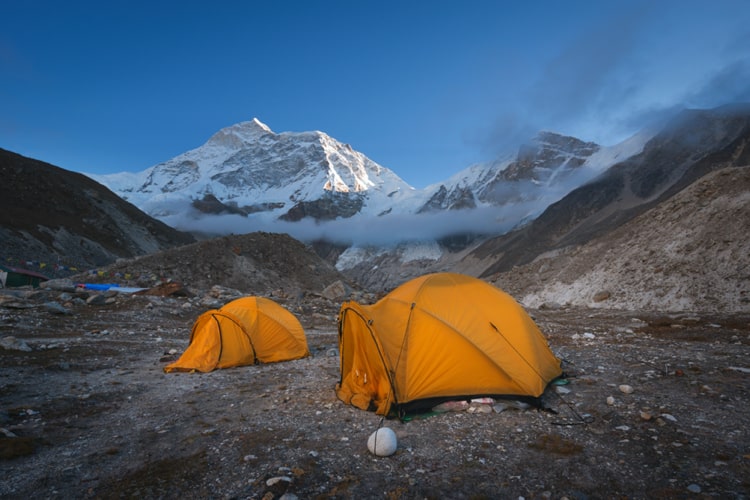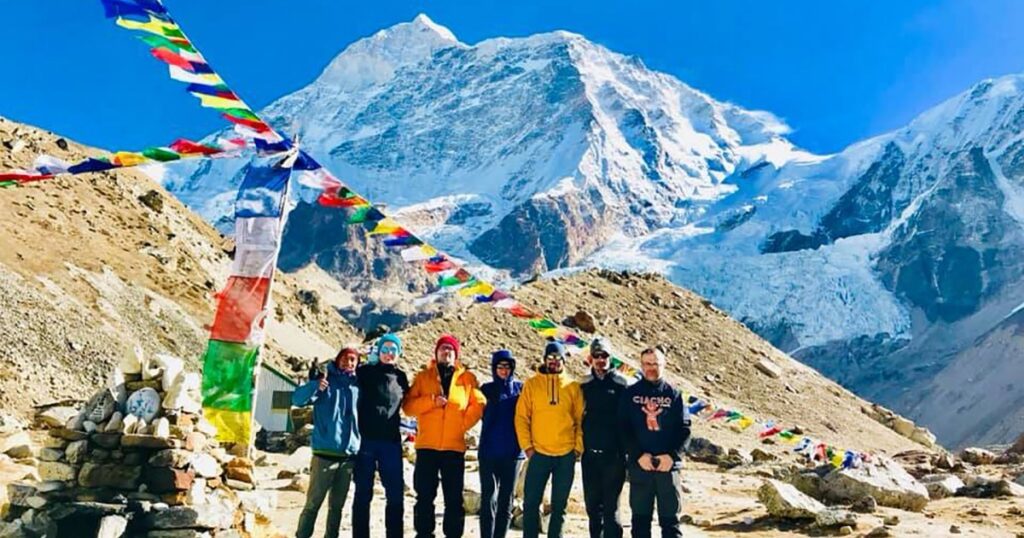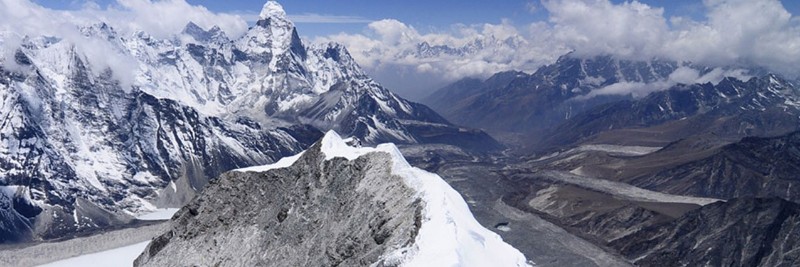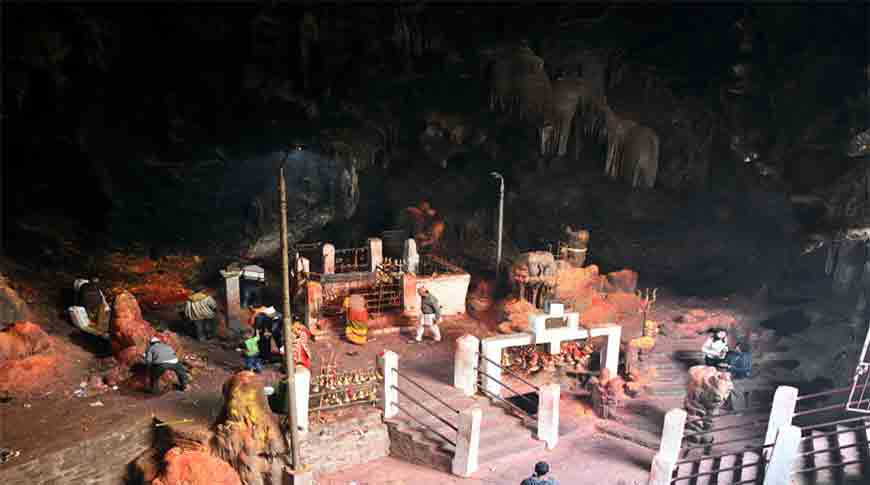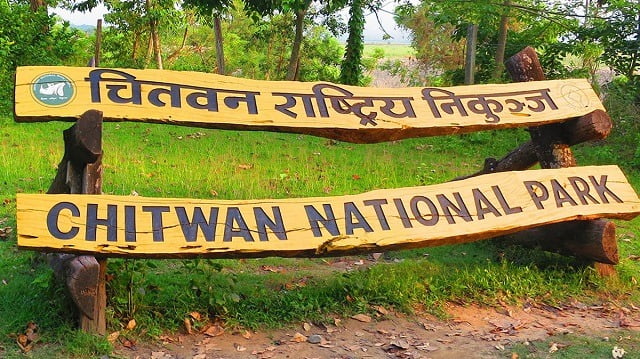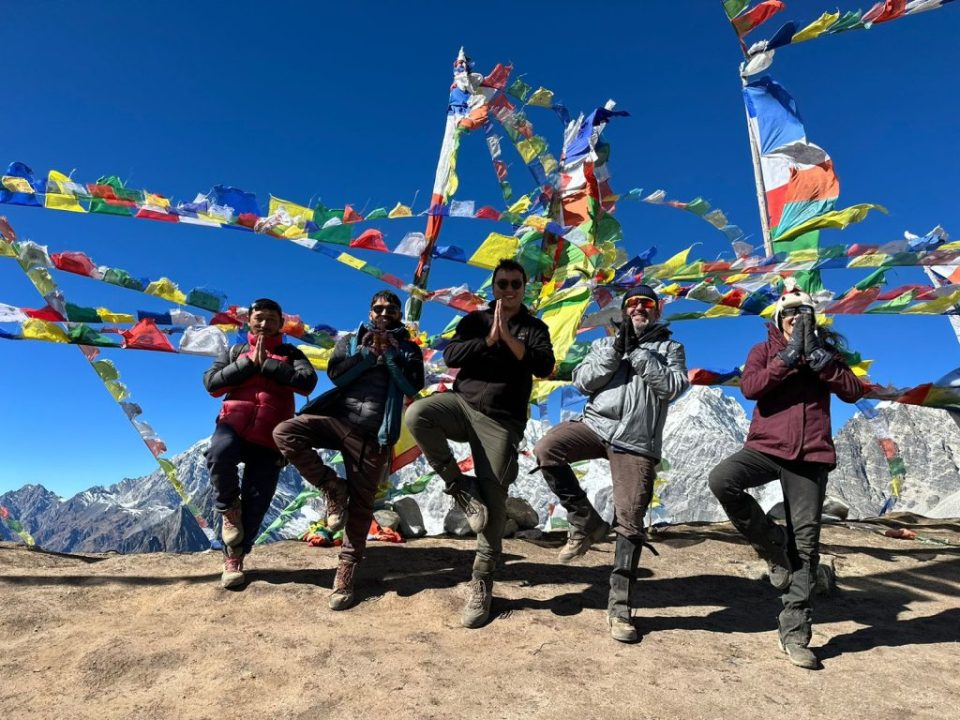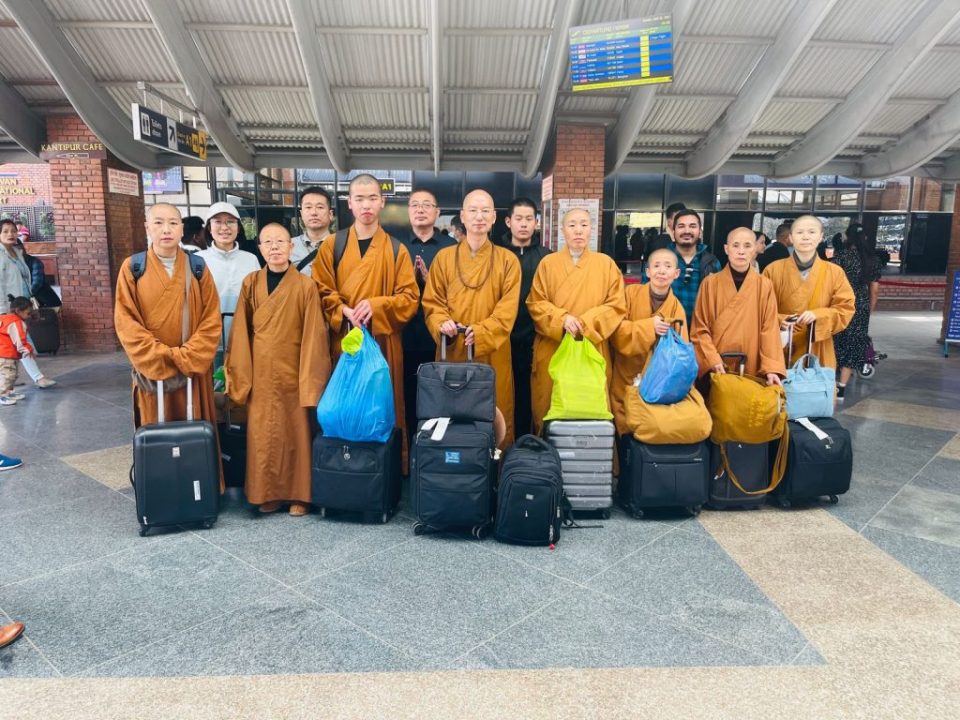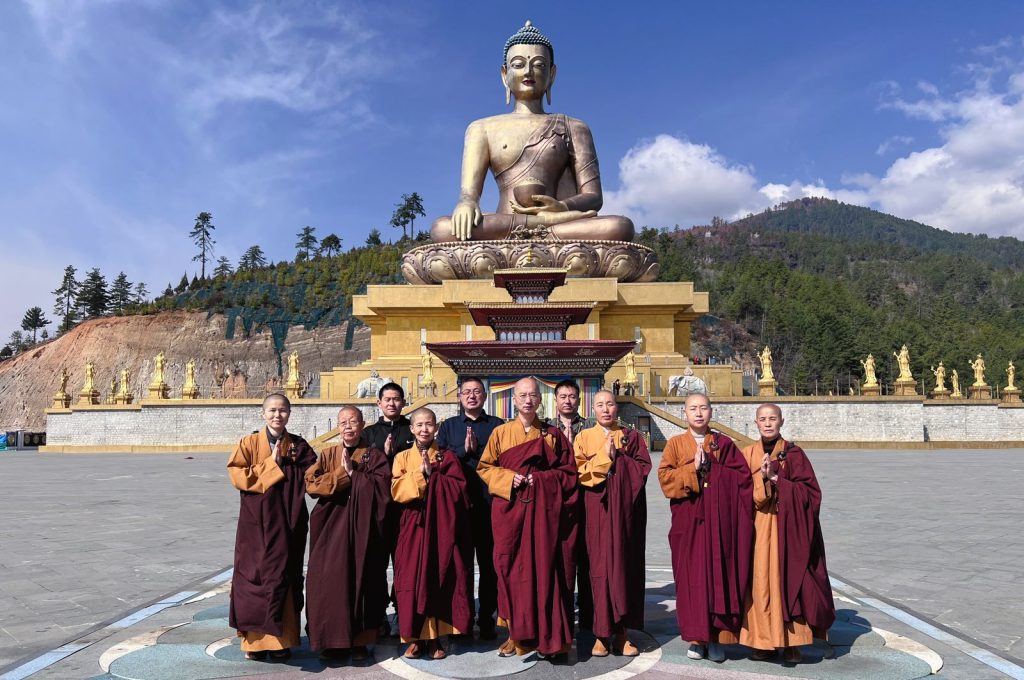Makalu-Base Camp Trek
Trip Introduction
Makalu Base Camp Trek is a remote trek that takes you to the isolated region of Nepal’s Makalu Barun valley. It is divided into two districts: Solukhumbu and Sankhuwasabha. Mt. Makalu is the world’s fifth highest peak. It is part of the Makalu Barun National Park. This trek is less popular than others Trekking region because it is more difficult to access. This trek is ideal for nature lovers because it has so much to offer.
Snow leopard, red panda, Musk deer, wild boar, wild yak, and Himalayan Thar are among the 3000 types of flowering plants, 440 species of birds, and 75 species of mammals found in the Makalu Barun National Park. The Gurung, Sherpa and Rai people live here. Mt. Everest, Mt. Lhotse, Mt. Chmalang, and Mt. Makalu can all be seen from here.
The journey of 20 days begins with the flight to Tumlingtar. We will then drive to the trek’s starting point, Chichila. We will pass through several picturesque villages, including Num, Seduwa, and Tasigaon. The trail leads to beautiful rhododendron forests and a charming Gurung village. Throughout the trek, you will be treated to breathtaking views of the mountains. The base camp trek begins at an elevation of 5100m. You will pass through several passes along the way, including KeKe La Pass, Shipton La, and TuTu La. Num Village is the trek’s end point.
Itinerary
Departure from : Kathmandu, Nepal
Arrival On : Kathmandu, Nepal
Day 1
Arrival at TIA Kathmandu
| Days | Activities | Durations |
| 1. | Arrival at TIA Kathmandu (1,400m/4,592ft) | |
| 2. | Fly to Tumlingtar and Drive to Chichila. (1,980m/6,497ft) | 3-4hrs |
| 3. | Trek from Chichila to Num (1,560m/5,118ft) | 6-7hrs |
| 4. | Trek from Num to Seduwa (1,500m/4,922ft) | 6-7hrs |
| 5. | Trek from Seduwa to Tashigaon (2,100m/6,890ft) | 4-5hrs |
| 6. | Trek from Tashigaon to Khongma Danda (3,500m/11,484ft) | 6-7hrs |
| 7. | Acclimatization Day | |
| 8. | Trek from Khongma Danda to Dobate (4,170m/13,683ft) | 6-7hrs |
| 9. | Trek from Dobate to Yangir Kharka (3,557m/11,671ft) | 6-7hrs |
| 10. | Trek from Yangir Kharka to Langmale Kharka (4,410m/14,469ft) | 5-6hrs |
| 11. | Trek from Langmale Kharka to Makalu Base Camp (4,870m/15,978ft) | 6-7hrs |
| 12. | Explore Makalu Base Camp | |
| 13. | Trek from Makalu Base Camp to Yangir Kharka (3,557m/11,671ft) | 6-7hrs |
| 14. | Trek from Yangir Kharka to Dobate. (4,170m/13,683ft) | 6-7hrs |
| 15. | Trek from Dobate to Khongma Danda (3,500m/11,484ft) | 5-6hrs |
| 16. | Trek from Khongma Danda to Tashigaon (2,100m/6,890ft) | 4-5hrs |
| 17. | Trek from Tashigaon to Seduwa (1,500m/4,922ft) | 4-5hrs |
| 18. | Trek from Seduwa to Num (1,560m/5,118ft) | 5-6hrs |
| 19. | Drive from Num to Tumlingtar (285m/935ft) | 4-5hrs |
| 20. | Fly Back to Kathmandu (1,400m/4,592ft) | |
| 21. | Departure |
Upon arrival at Tribhuvan International Airport (TIA). Our agent will greet you and accompany you to the hotel. Drive to the hotel and check-in. Our guide will come to see you in the evening and give you a brief overview of the journey. At the hotel, we had dinner and stayed the night.
Day 2
Fly to Tumlingtar and drive to Chichila
You will have an early breakfast at the hotel today before departing for your morning flight to Tumlingtar. The flight lasts approximately 35 minutes. When you arrive at the airport, our representative will meet you and drive you to Chichila. The drive will last approximately 2 to 3 hours. When you arrive in Chichila, you will be taken to the Teahouse. Chichila is the trek’s starting point. Dinner and Overnight at the Teahouse.
Day 3
Trek from Chichila to Num
Today is our first day of trekking, and we will depart for Num after breakfast. We’ll be walking for 6 to 7 hours. We’ll pass through Baisake and Kuwapani, two small villages. From there, we’ll make our way to Hururu, where we’ll have lunch. After lunch, we’ll climb and descend into a dense oak forest. From there, we’ll pass through Mure Village, where we’ll find Sherpa and Rai Settlement. We’ll make our way down the rocky trail to Num Village. Dinner and Overnight at the Teahouse.
Day 4
Trek from Num to Seduwa
We’ll leave for Seduwa after breakfast today. We’ll be walking for 6 to 7 hours. We will descend steeply from the western end of Num hill through Lumbang’s cornfield. The trail continues over the suspension bridge, ascending through the forest and passing through several villages. We’ll stop for lunch on the way. From there, we’ll continue ascending through dense forest to the Seduwa campsite. Dinner and Overnight at the Teahouse.
Day 5
Trek from Seduwa to Tashigaon
We’ll leave for Tashigaon after breakfast today. We’ll be walking for 4 to 5 hours. We will ascend before passing through the National Park Forest Project and arriving in Manigaon. The path then heads west, gradually ascending to Chyaksadanda and Ropesa. We’ll stop for lunch on the way, then continue to Tashigaon. Before arriving in Tashigaon, we will cross several streams and Paddy fields. Dinner and Overnight at the Teahouse.
Day 6
Trek from Tashigaon to Khongma Danda
We’ll leave for Khongma Danda after breakfast today. We’ll be walking for 6 to 7 hours. We’ll climb a rough trail in higher elevation through dense forest of remote bush and Rhododendrons, as well as several hills. We’ll stop for lunch on the way. The path will then become steeper as we pass through a series of stone stairs and climb the hill before arriving at Khongma. Dinner and Overnight at the Teahouse.
Day 7
Acclimatization Day
Today is a day of rest for us. Before ascending to the height, we must properly acclimatize our bodies. We will begin our day later than usual. After breakfast, we’ll go for a walk around the village and communicate with the locals. We will prepare for tomorrow. Dinner and Overnight at the Teahouse.
Day 8
Trek from Khongma Danda to Dobate
We’ll leave for Dobate after breakfast today. We’ll be walking for 6 to 7 hours. We’ll be ascending to the Shipton La Pass. From there, we’ll head toward Kalo Pokhari, where we’ll cross another pass, the Keke La Pass. We have breathtaking views of Chamlang, Peak 6, and Peak 7. We’ll eat lunch on the way. Following that, we will descend into the lovely Dobate Valley. Dinner and Overnight at the Teahouse.
Day 9
Trek from Dobate to Yangir Kharka
We’ll leave for Yangir Kharka after breakfast today. We’ll be walking for 6 to 7 hours. We will travel through the Rhododendron Forest to the Barun River and upper valley. We must be cautious while walking because the path is rough, steep, and difficult. We’ll stop for lunch on the way. We will gradually walk on the easy trail, gradually increasing our altitude until we arrive at Yangir kharka. Dinner and Overnight at the Teahouse.
Day 10
Trek from Yangir Kharka to Langmale Kharka
We’ll leave for Langmale Kharka after breakfast today. We’ll be walking for 5 to 6 hours. We’ll pass through yak pastures, dense forest, and gravel fields. The trail offers breathtaking views of the mountains. As we gain altitude, we will walk slowly. We’ll stop for lunch on the way. We’ll then make our way up to Langmale Kharka. Dinner and Overnight at the Teahouse.
Day 11
Trek from Langmale Kharka to Makalu Base Camp
We’ll leave for Makalu Base Camp after breakfast today. We’ll be walking for 6 to 7 hours. We will gradually ascend to the trail, which is flat with an icy glacier and mountains on either side. Shershong provides a view of Mt. Makalu. We’ll stop for lunch on the way. From there, we’ll make our way to Makalu Base Camp. Dinner and Overnight at the Teahouse.
Day 12
Explore Makalu Base Camp
We’ll have breakfast today with a spectacular view of Mt. Makalu. We’ll go for a walk around the Base Camp after breakfast. The bare base camp is surrounded by the massive Barun Glacier. There is a beautiful view of Mt. Makalu from the south, as well as a panoramic view of Mt. Everest and Mt. Lhotse. We will be mesmerized by the beauty of the mountains. Dinner and Overnight at the Teahouse.
Day 13
Trek from Makalu Base Camp to Yangir Kharka
We’ll go for Yangir Kharka after breakfast today. We’ll be out walking for 6 to 7 hours. We’ll take the same path back home. We’ll follow the dense forest and pass-through various settlements, including Shersong, Langmale, and Mereke, where we’ll get our last view of Mt. Makalu. We’ll stop for lunch on the way and then head down to Yangir Kharka. Dinner and Overnight at the Teahouse.
Day 14
Trek from Yangir Kharka to Dobate
We’ll go for Dobate after breakfast today. We’ll be out walking for 6 to 7 hours. We’ll pass through a valley, a beautiful forest, and rockfalls. To go to the Mathang, we’ll cross a wooden bridge covered in prayer flags. On the way, we’ll eat our lunch. We’ll progressively walk toward Dobate. Dinner and Overnight at the Teahouse.
Day 15
Trek from Dobate to Khongma Danda
We’ll go for Khongma Danda after breakfast today. From Dobate to Mumbuk, we’ll be climbing steeply. We’ll go through a forest of Rhododendrons and fir trees. We’ll stop for lunch on the way. On the journey, we’ll pass through the passes of Keke La, Shipton La, and Kauma La. We’ll descend to Khongma Danda from there. Dinner and Overnight at the Teahouse.
Day 16
Trek from Khongma Danda to Tashigaon
We’ll leave for Tashigaon after breakfast today. We’ll be walking for 4 to 5 hours. We’ll be descending a long and steep hillside. After that, the path heads west, gradually ascending to Chyaksadanda and Ropesa. On the way, we’ll stop for lunch before continuing to Tashigaon. Dinner and Overnight at the Teahouse.
Day 17
Trek from Tashigaon to Seduwa
We’ll leave for Seduwa after breakfast. We’ll be walking for 4 to 5 hours. We’ll leave the National Park behind and make our way down to the Barun River. We’ll stop for lunch on the way. From there, we’ll crisscross the hillside, pass through the villages, and make our way to Seduwa. Dinner and Overnight at the Teahouse.
Day 18
Trek from Seduwa to Num
We’ll leave for Num after breakfast. We’ll be walking for 5 to 6 hours. We’ll make our way up the stone steps. We’ll walk through the dense forest. The trail ascends and descends through a Sherpa settlement. We’ll stop for lunch on the way. From there, we’ll make our way to Num village. Dinner and Overnight at the Teahouse.
Day 19
Drive from Num to Tumlingtar
We’ll head for Tumlingtar after breakfast. We’ll be on the road for roughly 4 to 5 hours. It’ll be a bumpy ride. We’ll stop for lunch on the way. On arrival at the Tumlingtar, you will be transferred to Teahouse. Dinner and Overnight at the Teahouse.
Day 20
Fly Back to Kathmandu
You will have an early breakfast at the hotel before departing for your morning flight to Kathmandu. The flight lasts approximately 35 minutes. On arrival, you will be transferred to the hotel. The rest of the time is yours. Stroll around Kathmandu city on your last day at Kathmandu or just rest in a hotel. Dinner and Overnight at the Hotel.
Day 21
Departure
The 20 -day journey has concluded. Today is your last day in Kathmandu. Our representative will have a short discussion on the trip and take your feedback after a hearty breakfast. Following this session, we will drive you to the airport in our private transportation 3 hours before your flight.
Route Map
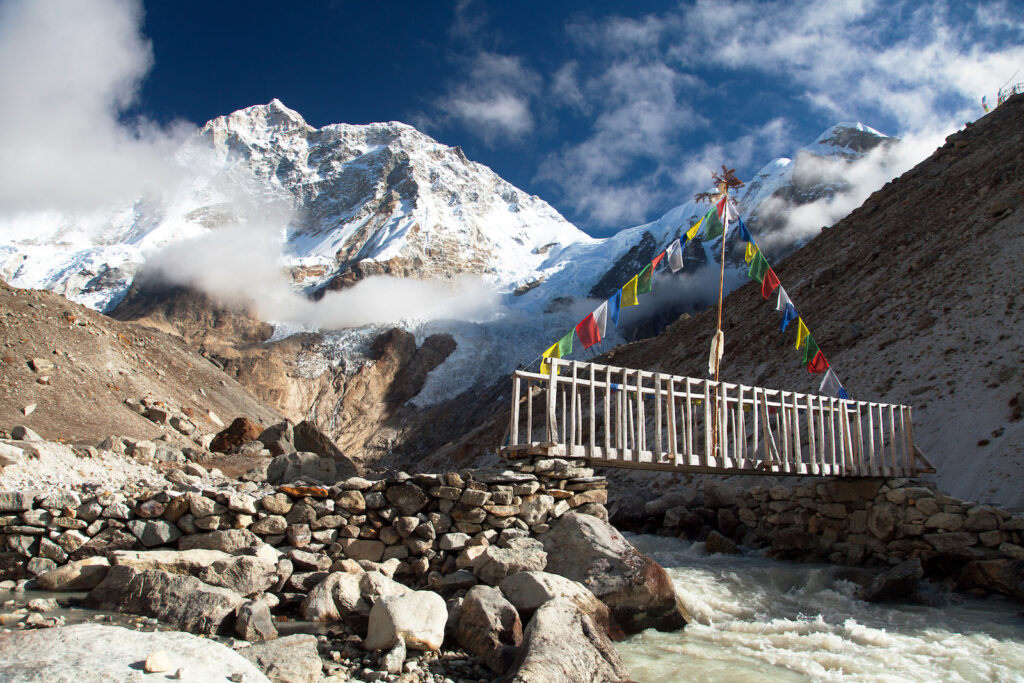
Altitude Map
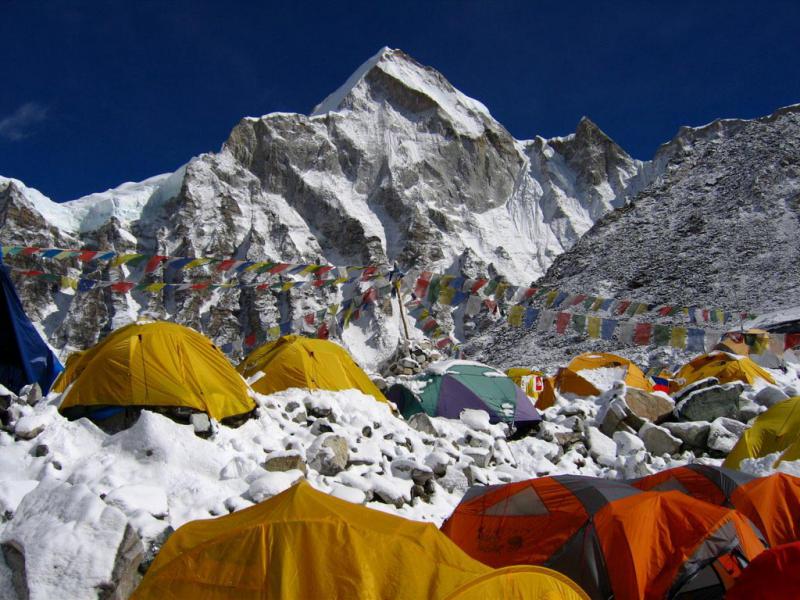
What's Included
- Arrival & Departure: Airport – Hotel transfer – Airport (Pick Up and Drop on private basis).
- Hotel Accommodation in Kathmandu: 2nights at Star categories hotel on twin sharing on bed and breakfast basis.
- Welcome Dinner and farewell dinner at Nepali culture restaurant in Kathmandu with Office’s Staff.
- Food & Lodging: 3 meals a day (Breakfast, Lunch, Dinner) along with accessible accommodation sharing during the trek.
- Permit: All necessary paper works: Makalu Barun National Park and Conservation Area Permit and Makalu Rural Municipality Permit.
- All government and local taxes if necessary.
- Trekking Map: Makalu Base Camp Trekking map.
- Member transportation: – Air Transportation: Flight from Kathmandu – Tumlingtar, and while returning.
- Road Transportation: Drive from Tumlingtar to Chichila and Num to Tumlingtar.
- Drinking: 2 liters of boiled water to carry on thermos per day per member.
- Guide: Government licensed Guide (English speaking) during the trek
- Porter: Porters (2 trekkers: 1 porter) up to 15kg during the trek.
- Insurance: Insurance for all involved Nepalese staff during the trek.
- Comprehensive Medical kit.
What's Not Included
- Air Fare: International flight airfare (from and to Kathmandu).
- Nepal Tourist Visa fee.
- Extra night in Kathmandu: Extra nights’ accommodation in Kathmandu. In case of early arrival or late departure, early return from Trekking (due to any reason) than the scheduled itinerary.
- Personal Insurance: Travel and high altitude insurance, accident, Helicopter medical & emergency evacuation. *Mandatory
- Personal Expenses: Telephone calls, Internet, Toiletries, battery recharge, hot shower, laundry, soft drinks, beer, and any alcoholic beverages.
- Personal Equipment: Clothing, Packing Items or Bags, Personal Medical Kit, Personal Trekking equipment.
- Rescue Evacuation: Medical and emergency rescue evacuation costs if required. (Rescue, Repatriation, Helicopter, Medication, Medical Tests and Hospitalization costs).
Equipment List
What to bring ?
General
Tailor Your Holiday
Everyone has their own preferences in terms of destination, journey time, and budget. As a result, sticking to our plan isn't necessary. We will create a personalized itinerary for you that includes accommodations, transportation, meals, and tour guides. We guarantee you the best Tailor-made Package because this is your trip. You have the option to personalize it, as your liking. Let us Plan together to make your Vacation worth it.
Fixed Departure
Why Travel With Us?
Secure Online Payment, No Credit Card Fee
Travel with Locals. Support Locals
Lifetime Deposit
Private & Tailor-Made Trips
24/7 International Support
Support Local Communities & Donate to Charity
All Inclusive Price
Secure Online Payment, No Credit Card Fee
Trip Facts
| Country | Nepal |
| Duration | 15 Days |
| Maximum Altitude | 4,870m/15,978ft |
| Region | Makalu |
| Meals | Breakfast, Lunch, Dinner |
| Accommodation | Hotel, Lodge, Teahouses |
| Grade | Challenging |
| Best season | Mar, Apr, May, Sep, Oct, Nov |
Trip Highlights
- Scenic Flight to Tumlingtar.
- Explore the Makalu Barun National Park.
- Pass through amazing George, Mountains, Terraced Farmland, and waterfalls.
- Enjoy the amazing views of Mt. Everest, Mt. Lhotse, Mt. Chmalang, and Mt. Makalu.
- Walk on the off-beaten trekking path of Makalu Base Camp.
Is this trek appropriate for you?
- The Makalu Base Camp Trek is the Challenging Trek. You can easily complete this trek if you are physically and mentally prepared and willing to do so.
- You will be Trekking for 17 Days. The Path can be completed in as little as 3 hours as much as 7 hours.
- The walk is not tricky, there is no Climbing or Scrambling but the path is rocky and hilly.
- Each day you will cover 200 to 400 meters in height while trekking. The highest point in the trek you will reach on the trek is 4,870m.
The weather and Remoteness of this trek, as well as dealing with the high altitude, require a slow pace and the need to stay hydrated
The ideal season to travel
Spring
March: The month of March is ideal for trekking and admiring the spectacular mountain peaks. The Makalu Base Camp trekking trail will be crowded with hikers beginning in March. In the Manaslu region, the spring season begins in March, the month of the Rhododendron. Trekking in March will provide you with the most memorable experiences in a pleasant and mild climate. At lower altitudes, the weather is not particularly hot, and at higher altitudes, it is not particularly cold. The views of the mountains are spectacular, and the trail is excellent. Nature can be experienced at its most beautiful.
April: April is the beginning of spring in Nepal, and the weather is ideal for trekking to Makalu Region. The views are bright and clear at this time of year, and everyone enjoys spring. The surroundings are vibrant and colorful, with rhododendrons in bloom. It is the best time of year to see various bird and butterfly species. During your April trip to Makalu, the weather is completely in your favor. The moderate heat of the sun, combined with the lack of wind, makes it ideal for trekking. Furthermore, the amount of rain and snow is insignificant.
May: May, the final month of the spring season in Nepal, is much hotter. The Makalu Region trek in May has the highest temperature of the year. Temperature and weather will vary depending on the altitude throughout the trek. During the day, the weather in the lower sections will be extremely hot. The nights, on the other hand, are tolerable.
Summer
June: June is the coldest time of the summer and has the least amount of rainfall. The month of June is the offseason and therefore less popular for trekking. In the region, June marks the start of the wet monsoon season. The weather is slightly humid, and you can enjoy nature while it is wet and cool. If you enjoy the rain, rainbows, and less crowded trails, this is the month for you. During this month, the air begins to become humid due to continuous rain.
July: Trekking in Nepal in July isn’t always joyful because the heavy rains can block your view of the beautiful mountains you’ll pass through. In July, you will notice that the temperature is not as chilly in the Makalu Region. As the rain washes away the dust and pollution, the environment opens up and becomes very fresh, and you will be able to enjoy nature despite the chilly weather.
August: In the Makalu region, August is the off-season for trekking. In August, the monsoon season produces strong rains, especially in lower places. Due to weather-related concerns, most hikers avoid this month. The summer monsoon season comes to an end in August. It rains regularly, and you may feel a little chilly as a result. You should also be cautious because the trails are slippery and the possibility of landslides and avalanches is considerable.
Autumn
September: The monsoon season finishes in September, marking the start of the fall season. The optimum time to trek to Makalu Base camp is in September. The weather and temperature for the Makalu Base camp Trek are ideal. The temperature is pleasant during the day, but it is extremely chilly at night.
October: October is the month that falls between September and November. As a result, it keeps both monsoon rain and winter’s biting cold at distance. The weather is warm and pleasant in October, with clear skies and fresh air. The nights, on the other hand, are a little chilly, with a brisk breeze coming from the campsite. Throughout October, the weather is pleasant, allowing people to enjoy an unobstructed view of the snow-capped peaks. They can also visit bright valleys and interesting scenery of various colors.
November: The last declared peak season for trekking in Nepal is November. Bright, sunny days and beautiful skies characterize November. On the treks, these provide breathtaking, crystal-clear vistas of the mountains. The days are bright and sunny in November. The sky is clear, with perhaps a few stray clouds possible.
Winter
December: In the Makalu region, December is a rather dry month. It receives fewer than 25 millimeters of rain every year. The Makalu region is in the shadow of the Himalayas. As a result, December has a lower chance of rain. It is also possible to walk the Makalu Base Camp Trek in December. In December, hikers will get a unique perspective of the region.
January: In Nepal, January is in the midst of winter. The higher elevation receives moderate snowfall, whereas the lower elevation is ideal for trekking. During the day, you will feel warm, but as night falls, you will feel cold. In January, these areas receive little to no rainfall. As a result, the skies remain clear and the surroundings appear even sharper. The trails will be covered in snow, so you may need crampons to cross the pass.
February: The Makalu Region trek in February is an escape from the hustle and bustle of everyday life to a place where all you can see are mountains and scenery. It’s peaceful because February is the coldest month of the year. Most people dislike trekking in the winter because they believe it is extremely difficult.
Flight to Tumlingtar
- Almost every trip begins with a flight from Kathmandu to Tumlingtar Airport. As it is the easiest way for your trek to the Makalu Base Camp Trek.
- The domestic airport of Tumlingtar is located in Tumlingtar, Sankhuwasabha District.
- The airport is located at a height of 518meters above sea level. It only has one runway.
- The flying time is around 35 minutes. During the monsoon season, flights are frequently delayed or canceled.
- The flight only Operates from Kathmandu and Biratnagar airport.
Altitude sickness
Beyond 2500m (8000ft), Altitude sickness is a sneaky monster that may attack even the fittest trekkers. These demands do everything in your power to prepare for altitude trekking and take things carefully throughout your Makalu Base Camp trek. With increasing altitude, the amount of available oxygen decreases, which is the primary cause of high-altitude sickness.
So, you may suffer from different altitude sickness in the altitude of i.e., Acute Mountain sickness (AMS), High pulmonary edema (HAPE), and High-altitude cerebral edema.
Your body requires time to adjust to thin air, so start at a lower altitude and work your way up. Some of the symptoms of Altitude sickness are:
- Increased breathing.
- Increased urination.
- Restless sleep.
- Periodic breathing at night because of altitude.
- Dehydration.
- Shortness of breath.
- Extreme fatigue.
- Respiratory failure.
- Cerebral edema.
- Coma.
Certain care should be made to ensure that the situation does not worsen. However, if the symptoms worsen, you may need to return to a lower height and seek medical help. There are, however, several other precautions you may take while trekking in the Everest region to lessen your risk of altitude sickness.
- Trekkers can modify their bodies by slowly and gradually climbing, as our bodies require time to adjust to the oxygen level. For high altitude trekking, at least one day of acclimatization rest is essential, and you should ascend as high as possible before returning to a lower altitude for the night.
- You should do various strength training exercises such as running, cycling, jogging, push-ups, and going to the gym to acquire strength and stamina for your adventure.
- As the air gets increasingly thin, an increase in elevation reduces oxygen levels, and in the Makalu region trek, an increase in altitude also means less vegetation. The consumption of alcoholic beverages, cigarettes, and tobacco decreases the body’s water content.
- The greatest remedy is to always stay hydrated. On your walk, instead of drinking cooled water, drink warm water.
- Diamox is the most effective altitude sickness medication; thus, you should bring a subscription with you on the trek. However, you should consult with your physician to see whether it is advantageous.
Things to know before traveling to Makalu Region.
Drinking-Water in Makalu Region.
Trekkers must hydrate their bodies at a higher altitude than in lower elevations to avoid dehydration and altitude sickness. Lack of fluid can be the main hindrance during the trek. You should hydrate your body with at least 3-4 liters of water daily (Tea, soup, or normal drinking water).
There are plenty of streams/ water resources to refill your bottle on the way to Makalu Base camp. But it is not safe to drink without purifying. So, use purifying tablets or water filters to treat water before drinking.
Besides that, the other places to get drinking water are local teahouses/guesthouses and lodges, but it is also unsafe to drink without being purified or boiled. The teahouse also provides boiled drinking water. Coldwater is provided free of charge, but for boiled water, you have to pay a certain amount. Bottled water is also available but the cost gets higher as you gain altitude. It will cost around 2$-3$ per bottle/liter.
Every day, you must carry enough water for the day before beginning the trek because in someplace you won’t find any water resources on the trail. We recommend you bring a Reusable water bottle of 2-3ltr or water pouch favorable for both hot and cold water.
Here are some ways that you can use to make the water drinkable.
- Boiled water
Boiling water is the best way to purify the water. As we are climbing to a higher altitude you need to boil the water for about 3-minute and season it with a pinch of salt before drinking. You can get free tap water in the teahouse/guesthouses but for boiled water, it cost a certain amount.
- Purification tablets or electrolyte powder.
Purification tablets like chlorine or iodine tablets are commonly used tablets by trekkers to disinfect the water. 1 tablet is enough for a liter of water. It takes around 30 min for the tablets to dissolve and become drinkable. Water, purify by tablets may leave a taste in your mouth.
Electrolyte powder is another option. Electrolyte powder is a better way to purify water than tablets because electrolyte powder contains minerals such as salt, Potassium, Magnesium, which are important for your body during the trek.
- UV Light water purifier/ SteriPEN.
It is a simple, effective, economic, and environment-friendly way to purify water. It kills the bacteria and virus within 10 sec by exposing them to ultraviolet light using Steripen, without changing the flavor of the water. This is a highly recommended means of purifying water.
Electricity and Internet facility in Makalu region.
Electricity facility.
Though the Makalu region is the remoteness area, you won’t be in darkness during the trek to the Makalu region. The whole Makalu region is either powered by Hydroelectricity or a Solar panel/ battery.
The lower area of the Makalu region is powered by local hydroelectricity so there will be a charging socket in your hotel/lodge’s rooms. However, the people in the Upper area of the Makalu region still relies on Solar panel or solar power battery for electricity that is enough to light the bulbs and charge small devices. And there will be no charging socket in your room. There is a commonplace for charging usually in the dining area. You might be able to charge a normal mobile set, camera battery, and power bank from the solar power battery/generator by paying extra. Solar battery power might harm your device, so charge it at your own risk. As a result, it is recommended that you bring a power bank and spare camera batteries that will last the duration of your trek.
Internet Facility and Network Service
Makalu region does have Wi-Fi/internet access, but it lacks a stable connection as you climb to higher altitudes. Few lodge/ teahouses in the Makalu region have Wi-Fi availability. Some provide it free of charge and some charge an amount. However, you can connect to the internet via. Your cellular network’s data package.
Both NTC and NCell cellular service has been providing the GSM and CDMA network connectivity in Makalu Region. You will be connected until you are within the coverage of the signal. You can buy the NCell or NTC sim card from the stores in Kathmandu for 1USD. By taking data packages you can use the internet service up to Makalu base camp, only when the mobile network catches a signal. It is not guaranteed that your mobile network will have a signal all the time. Or buy a satellite phone.
NTC cellular service is most preferred over NCell. NTC provides good service and signal connectivity, in comparison to NCell.
| Buy NTC data package
Dial*1415# |
Cost of data package in NTC:
-14GB=7$ (Valid up to 28days -30GB=15$ (Valid up to 90 days) |
Check balance
Dial *1415# |
| Buy NCell data package
Dial *17123# and select. |
Cost of data package in NCell:
-15GB=10$ -25GB= 12$ (Valid up to 30 days) |
Check balance
Dial*101# |
Document needed to buy a sim card.
For Foreigner = 1 passport size photo, Passport photocopy, or valid identity card.
For Nepali = 1 Passport size Photo, Photocopy of Citizenship.
Some useful tips to avoid the problem of No electricity.
- Extra batteries for the camera.
- Power bank with 5000-10000mAh.
- The solar charger and solar lamp (LuminAID Nepal lamp)
- As possible less usage of a device with low brightness, GPS, and airplane mode.
Electricity facility.
Though the Makalu region is the remoteness area, you won’t be in darkness during the trek to the Makalu region. The whole Makalu region is either powered by Hydroelectricity or a Solar panel/ battery.
The lower area of the Makalu region is powered by local hydroelectricity so there will be a charging socket in your hotel/lodge’s rooms. However, the people in the Upper area of the Makalu region still relies on Solar panel or solar power battery for electricity that is enough to light the bulbs and charge small devices. And there will be no charging socket in your room. There is a commonplace for charging usually in the dining area. You might be able to charge a normal mobile set, camera battery, and power bank from the solar power battery/generator by paying extra. Solar battery power might harm your device, so charge it at your own risk. As a result, it is recommended that you bring a power bank and spare camera batteries that will last the duration of your trek.
Internet Facility and Network Service
Makalu region does have Wi-Fi/internet access, but it lacks a stable connection as you climb to higher altitudes. Few lodge/ teahouses in the Makalu region have Wi-Fi availability. Some provide it free of charge and some charge an amount. However, you can connect to the internet via. Your cellular network’s data package.
Both NTC and NCell cellular service has been providing the GSM and CDMA network connectivity in Makalu Region. You will be connected until you are within the coverage of the signal. You can buy the NCell or NTC sim card from the stores in Kathmandu for 1USD. By taking data packages you can use the internet service up to Makalu base camp, only when the mobile network catches a signal. It is not guaranteed that your mobile network will have a signal all the time. Or buy a satellite phone.
NTC cellular service is most preferred over NCell. NTC provides good service and signal connectivity, in comparison to NCell.
| Buy NTC data package
Dial*1415# |
Cost of data package in NTC:
-14GB=7$ (Valid up to 28days -30GB=15$ (Valid up to 90 days) |
Check balance
Dial *1415# |
| Buy NCell data package
Dial *17123# and select. |
Cost of data package in NCell:
-15GB=10$ -25GB= 12$ (Valid up to 30 days) |
Check balance
Dial*101# |
Document needed to buy a sim card.
For Foreigner = 1 passport size photo, Passport photocopy, or valid identity card.
For Nepali = 1 Passport size Photo, Photocopy of Citizenship.
Some useful tips to avoid the problem of No electricity.
- Extra batteries for the camera.
- Power bank with 5000-10000mAh.
- The solar charger and solar lamp (LuminAID Nepal lamp)
- As possible less usage of a device with low brightness, GPS, and airplane mode.
Essential Backpack items for Makalu Base Camp Trek.
The bag of a trekker also reveals the trekker’s level of experience. A good trekker should be a smart backpacker. You should be pre-prepared for the things that you need in the trek. As this trek is in a remote area, there won’t be any shops once you start your trek, so need to bring enough supplies that you need in the trek.
Here are some of the things that you need to take with you for the trek.
Travel documents
- Airline tickets with the itinerary.
- Travel insurance policy documents.
- Original valid passport.
- Copies of passport.
- Passport-sized photos.
- Nepalese cash.
- Travel permits.
Clothing
- A pair of waterproof trekking shoes or hiking boots.
- A pair of flip flop slippers or running shoes.
- 2-3 Sets of thermals (leggings and tops)
- Pairs of hiking long sleeve shirts or tops.
- Pairs of hiking shorts and pants.
- Fleece jumpers or a set of tracksuits.
- Good quality windproof down jacket.
- Lightweight waterproof rain jacket and pants.
- Neck gaiter, leg warmer, and packet of pocket hand warmers.
- 5-6 pairs of quick-dry socks, underwear, and sports bra.
- Pair of inner and outer gloves.
- Knitted Hat, sun cap, beanie, or bandana.
- Glacier Sunglasses and eyeshade.
Trekking equipment
- Waterproof trekking bag of 40-50liter and Rucksack of duffel bag (if your backpack is not enough for all your item and need a potter).
- Reusable water bottle (both hot and cold) of at least 2-3litre.
- A sleeping bag and sleeping bag liner.
- Trekking stick/ poles.
- Route Map of Makalu Base Camp.
- Crampons (if you are trekking in the winter season, Dec-Feb).
- LED Headtorch or solar lamp (LuminAID Nepal lamp is best as it is solar-charged and very much portable)
- Stuff sacks, paper bags.
- Plug adapter, Charging appliances, Power bank, Camera batteries.
- Pocket knife.
- Travel Wallet.
Toiletries
- Rolls of Toilet paper, wet wipes, and tissue.
- Medium-sized quick-drying towel.
- Toothbrush and toothpaste.
- Hand sanitizer.
- Sunscreen, lip balm, body lotions.
- Deodorants.
- Portable mirror.
- Shampoo and soap.
Personal First Aid Kit
- Antibiotics
- Painkillers, Paracetamol, ibuprofen, aspirin, Nicole
- Sanitary pads
- Bandage.
- Anti-inflammatory spray.
- Anti-Nausea tablets.
- Anti-diarrhea pills or power.
- Altitude sickness tablets- Diamox
- Water purifying tablets or electrolyte powder.
- Mosquito and Insect Repellent.
- Salt or anti-leech oil (If traveling in the rainy season, July- Aug)
- Earplugs
You can buy or hire trekking clothes and equipment in Thamel, Kathmandu. If you are buying it, you have to allow an extra day for shopping; however, if you are hiring it, you must inform us in advance so that we can arrange it before you arrive in Kathmandu. This way you can reduce the weight of your luggage and save time and money.
Branded, New as well as fake, and used trekking clothes and equipment are available around the Thamel area at a reasonable price.
Accommodation, Meal, and Transportation
Accommodation
We will accommodate in star hotel during our stay in Kathmandu.
During the trek, we will accommodate in hotel/lodges/teahouses.
Meal
During the trek, we will provide you three-time meals. You can choose from the given menu.
Breakfast– Tibetan Bread/ Chapatis, Buckwheat Roti, Boiled egg, omelets, Boiled potato, Tsampa porridge,
Lunch– Dal Bhaat set (Rice, Vegetable curry/ Meat curry, Lentils, Pickle, Cucumber Salad, Papad), Fried rice, Chowmein, Thukpa-Tibetan Noodle soup, Garlic soup, Noodles soup, Mo; Mo (dumplings), etc.
Dinner– Dal Bhaat set (Rice, Vegetable curry/ Meat curry, Lentils, Pickle, Cucumber Salad, Papad), Fried rice, Chowmein, Thukpa-Tibetan Noodle soup, Garlic soup, Noodles soup, Mo; Mo (dumplings), etc.
These are the options of food that you will find mostly on the trek to Makalu Base camp.
Transportation
By Bus- from Kathmandu airport to hotel at Kathmandu and vice-versa.
From Tumlingtar to Chichila.
From Num to Tumlingtar.
By Air– Flight from Kathmandu to Tumlingtar and returning.
Guide and Staff Arrangements
Throughout the trek, all your activities will be handled by our well-qualified and professional staff. They will do all the escorting. As this is one of the tricky treks, we are providing you with a highly experienced and licensed guide with fluent English speaking and has excellent navigation and technique of rope fixing skills. They will accompany you from Kathmandu and guide you during the whole journey to Makalu Base Camp. Each group of 4-5 trekkers will be assigned an assistant guide, as well as a porter for two trekkers (2*15kg =30kg). If your luggage weighs more than 15kg you will be provided a porter individually but you will be charged for 2 people.
All our lead guides, assistant guides, and potters are well professional and experienced. So, we hope for your respect and cooperation with them throughout the trek.
A typical day on the Makalu Base Camp trek.
Every day will begin with the ringing of your alarm clock at 6 a.m. and a knock on your door from your guide with the invitation of breakfast. Get up, have breakfast, pack your backpack and get ready to start your day’s walk by 7 a.m. We need to start our trek early to avoid the scorching sun and in the midafternoon the wind gets stronger compared to the morning in higher altitudes.
You’ll walk along the lush forest of Rhododendron, Oaks, and Pine; clicking photos; creating memories; interacting with your guide; hearing each other’s stories. Lunch will be served at a local teahouse/guesthouse in the afternoon. Having the flavorful Dal Bhat and an hour of rest, we will proceed to the day’s final destination as per the itinerary.
On arrival at the destination, check into your accommodation. Get freshen up and some rest. As every teahouse/lodge/guesthouse where we stay has a common dining area with a wood-burning stove in the center, there you will get to meet other travelers. You can sit there, laugh at each other stories, play cards, sing songs, play music, and have a good time. This will help you forget all the tiredness of the day. Later in the evening, you will have your dinner together. After dinner, your guide will give a short briefing about the next day’s trek regarding when you must get up when we have to start our trek the next day, where we will stay the next day, how many hours we have to walk, and so on.
During this 17-day trek to Makalu Base camp, you will walk for a minimum of 4 hrs to a maximum of 7hrs in a day. You will have a scenic flight from Kathmandu to Tumlingtar and a drive to/from Chichila, before starting and ending your trek. You will walk on the off-beaten rocky path over the dense forest of Makalu Barun National Park and Conservation Area. During this trek, you pass through the amazing George, Mountains, Terraced farmland, Waterfalls, and villages of Sherpa and Rai. You will stay a night under the shadow of the 5th highest mountain of the world –Mt. Makalu (8463m). Admiring the view of Mt. Everest, Mt. Makalu, Mt. Chmalang, Mt Lhotse, and the mesmerizing beauty of Makalu Region, you will complete the Makalu Base Camp trek. Every stop along the way will be a wonderful day. Your hard walk will be rewarded when you complete the trek with lifelong memories.
Nepal Tourist Visa and permits details
Visa procedure.
To travel to Nepal, you’ll need a tourist visa that is valid for the period of your stay in Nepal. Better, you have a tourist visa valid for at least 1 month because anything can happen during the trip, and staying in Nepal after your visa expires would result in you paying a penalty. Apply for a visa at your nearest Embassy of Nepal or obtain an On-Arrival visa at immigration in Tribhuvan International Airport, Kathmandu. But it’s better to contact your nearest Nepalese Embassy.
Here are the documents that you need, to apply for the tourist visa.
- The Tourist Visa Application Form for Nepal (Fully completed online and printed)
- Original Passport with at least 2 blank pages and validity of at least 6 months.
- Photocopies of your passport’s information page.
- At least 2 recent passport-sized photos of yourself with white background.
- Proof of accommodation in Nepal.
- Valid travel and return flight tickets.
- A bank statement from the last 3 months with a minimum closing balance of NPR 2, 00,000.
- Receipt of the visa fee for Nepal.
Note: 15 days visa that costs USD 30. Our trip is for 21 days, so apply for 30 days tourist visa, which costs USD 50. For 90 days visa costs USD125.
Entry permits and Requirements
Mt. Makalu Base Camp (the 5th highest mountain in the world) lies under the Makalu Barun National Park and Conservation Area, you have to obtain some permits from the government to trek to Makalu Base Camp. The Entry permits that you need for the trekking to Makalu Base Camp are;
| Trekking permits | Foreign Nationals | SAARC Nationals | Nepali Citizens | |
| 1. | Makalu Barun National Park and Conservation Area Permit. | NPR 3,000 per person per entry.
NPR 25 for tourist porter. |
NPR 1,500 per person per entry.
NPR 25 for tourist porter. |
NPR 100 per person per entry.
NPR 25 for tourist porter. |
| 2. | Makalu Rural Municipality Permit | NPR 2,000 per person. | NPR 2,000 per person. | NPR 2,000 per person. |
Note– Makalu Rural Municipality Permit must be obtained from the Makalu Rural Municipality entrance counter. TIMS Card has been replaced by this permit.
Makalu Barun National Park and Conservation Area Permit can be issued from Nepal Tourism Board, Bhirkuti Mandap, Kathmandu, or from the entrance gate of Makalu Barun National Park. But to save time get the Makalu Barun National Park and Conservation Area Permit from Nepal Tourism Board, Bhirkuti Mandap, and Kathmandu.
For more information about Trekking Permit here is the link.
(If you are traveling from a travel/trekking agency your agency will arrange all the Permits.)
Documents required to get these permits.
- Complete the permit form with your passport details and tour details (Trekking area, Entry and Exit date, and point, Route of Trekking, Emergency contact information for Nepal and your Home country).
- Passport size photos.
- Original passport with a valid visa
- Photocopies of passport personal information page.
- Copy of Travel Insurance policy to obtain TIMS card.
Travel Insurance
During the journey, you may encounter several unexpected incidents or losses. Trekking in Nepal is an adventurous and occasionally dangerous activity, especially at high altitudes. Trekkers must have travel insurance before visiting Nepal for trekking. During this 17-days trek to Makalu Base Camp, you may encounter a physical injury, illness, or an unexpected accident, and you will be responsible for all medical expenses and losses.
Choose an insurance policy that covers all of your possible risks from the start of your journey to your final destination. The following threats should be covered by your travel insurance:
- Cancellation of Domestic and International flights.
- Lost and stolen baggage and passport.
- Hospital and Medical expenses (physical injury, Acute Mountain sickness, Altitude sickness, sudden accident)
- Emergency rescue such as Helicopter.
- All high-altitude trek dangers up to 5,000m.
You need to choose your travel insurance wisely so that, in the case of such an incident, your travel insurance will cover the costs.
You can get your travel insurance in either your home country of Nepal.
Responsible Travel
Makalu Region is a remote area and is protected by the government as a conservation area because of the National Park and 5th highest mountain of the world, Mt. Makalu. You have to respect the local people and their local culture. We expect you to dispose of the plastic garbage properly. Your small act of neglect and disrespect can cause a major problem in the future.
Your responsible travel will help Nepal achieve long-term sustainable tourism.
FAQs
How much time should I spend on the path each day?
It depends on the person’s walking pace, but you should walk for at least 3 hours and no more than 7 hours per day.
How much money should I spend per day on trial?
You will spend a minimum of USD 30 to 50 per day, including your accommodation and three meals. If you travel with us, your package includes accommodation and three meals per day. As a result, you should consider your expenses such as beverages, snacks, and hot water, as well as charges, Wi-Fi, and so on.
What permits are needed while trekking in Makalu Region?
- Makalu Barun National Park Permit.
- Tourist Information Management System card (TIMS Card)
How is the Drinking water facility in Makalu Region?
Drinking water is not safe, so you should purify or boil it before drinking it, or you can purchase mineral water at a cost.
How are the Tea Houses in Makalu Region?
Tea houses have Basic facilities because they offer a Limited variety of food items on their menu. The rooms are spacious, with two beds and blankets. They have a western toilet and hot water for showers.
What should we avoid while trekking in Makalu Region?
You should not disturb wildlife while trekking and should walk quietly; you should not listen to music while passing through the forest. It is best not to drink alcohol while trekking.
What’s the perfect season for Trek in Makalu Region?
The best seasons to go on a trek in the Makalu region are autumn and spring because the weather is pleasant with beautiful mountain views and clear blue skies. You will enjoy the trail because it is densely forested with Rhododendron.
Can we do the Makalu Base Camp trek without a guide?
Yes, you can trek to Makalu Base Camp without a guide. Because it is the least popular trekking trail, there will be very few trekkers on the route, and because there isn’t much on the signboard in the path, you may become confused, so be careful while trekking.
Makalu-Base Camp Trek
Trip Reviews
Lorem ipsum dolor sit amet, consectetur adipisicing elit, sed do eiusmod tempor



